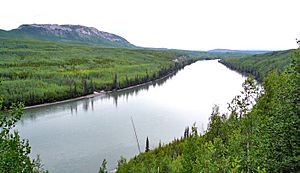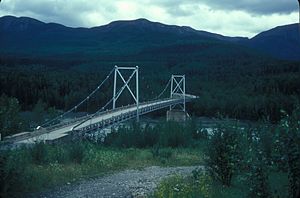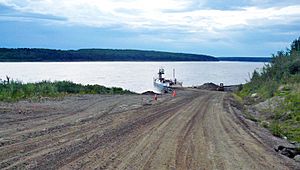Liard River facts for kids
Quick facts for kids Liard River |
|
|---|---|
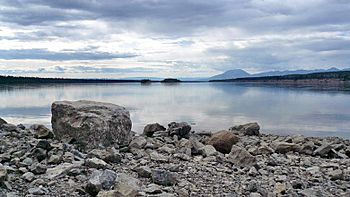
Liard River, Nahanni Ranges on western horizon
|
|
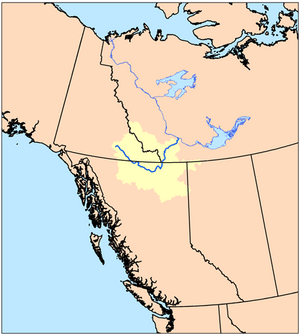 |
|
| Country | Canada |
| Province | British Columbia |
| Territories | |
| Physical characteristics | |
| Main source | Mount Lewis Pelly Mountains, Yukon 1,500 m (4,900 ft) 61°14′12″N 131°37′39″W / 61.23667°N 131.62750°W |
| River mouth | Mackenzie River Fort Simpson, Northwest Territories 120 m (390 ft) 61°50′23″N 121°17′58″W / 61.83972°N 121.29944°W |
| Length | 1,115 km (693 mi) |
| Basin features | |
| Basin size | 277,100 km2 (107,000 sq mi) |
| Tributaries |
|
The Liard River is a long and important river in Canada. It flows through the huge northern forests of Yukon, British Columbia, and the Northwest Territories. The river starts in the Pelly Mountains in southeastern Yukon. It then flows for about 1,115 kilometres (693 mi) through British Columbia. The Liard River marks the northern edge of the Rocky Mountains. Finally, it turns northeast and flows into the Mackenzie River at Fort Simpson, Northwest Territories. The river drains a very large area of land, about 277,100 square kilometres (107,000 sq mi), which is covered in forests and wetlands.
Contents
Exploring the Liard River's Geography
The Liard River is part of a larger natural area called the Lower Mackenzie Freshwater Ecoregion. The land around the river in Yukon is known as the Liard River Valley. A famous road, the Alaska Highway, follows the river for part of its journey. This area is also called the Liard Plain, which is a flat part of the larger Yukon–Tanana Uplands. The Liard River is an important crossing place for animals like the Nahanni wood bison.
The Liard River's History
Nobody is quite sure where the name "Liard" comes from. It likely comes from a French word for "Eastern Cottonwood". These are a type of poplar tree that grows a lot along the riverbanks. Early fur traders, who explored and traded in the area, called the part of the Liard above the Fort Nelson River the "West Branch." The Fort Nelson River itself was called the "East Branch."
First European Explorers
The first European to travel along most of the Liard River was John McLeod. He was an explorer for the Hudson's Bay Company (HBC), a big fur trading company. On June 28, 1831, McLeod and eight other people started their journey from Fort Simpson. They traveled up the river and, after about six weeks, found and named the Dease River. A few days later, they reached the Frances River. They thought it was the main part of the Liard, but they were mistaken.
Nine years later, another HBC employee named Robert Campbell explored the river further. He journeyed all the way to the source of the Liard in the St. Cyr Range. Campbell then renamed the river that McLeod had explored. He named it after Frances Ramsay Simpson, who was the wife of Sir George Simpson. Sir George was the governor of the Hudson's Bay Company and had approved both of these important expeditions.
Amazing Features of the Liard River
The Liard River has several interesting natural and historical features:
- Grand Canyon of the Liard: This is a 30-kilometre (19 mi) long part of the river. It starts just east of the Liard River Hotsprings. This section has many difficult rapids, known as class IV (and higher) rapids. It is located between where the Toad River and Trout River join the Liard. In the past, people studied this area to see if a hydroelectric dam could be built there.
- Liard Canyon: This is a different canyon from the Grand Canyon. It is located near a place called Lower Post.
- Liard River Hotsprings: This is a very popular place for tourists to visit. It's located at kilometre 765 along the Alaska Highway. People enjoy swimming in the warm natural springs here.
- Liard River Suspension Bridge: This historic bridge was built in 1944. It is located at kilometre 798 of the Alaska Highway.
The Liard River's Journey
The Liard River flows through three different parts of Canada. Let's follow its path:
Starting in Yukon
The Liard River begins in the southeastern part of Yukon. It starts on the slopes of Mount Lewis, high up at about 1,500 meters (4,900 ft) (nearly a mile high!). From there, it flows south and east, winding its way between the Pelly Mountains. As it moves through the Yukon Plateau, smaller streams like Prospect Creek join it. The river then turns east and continues to collect water from other creeks like Swede and Junkers Creek.
The Liard follows the southern edge of the St. Cyr Range and the Simpson Range. Many more creeks, such as Old Gold Creek and Rainbow Creek, add to its flow. It continues southeast, north of the Cassiar Mountains, and receives water from Sayyea Creek and Black River. Before leaving Yukon, the Liard River passes through Upper Liard and west of Watson Lake, Yukon. Here, the Alaska Highway crosses the river. After receiving Cormier Creek, it flows through the Liard Canyon and enters British Columbia.
Flowing Through British Columbia
In British Columbia, the Liard River flows southeast and east, often alongside the Alaska Highway. It gathers water from many rivers and creeks, including the Dease River and the Hyland River. The river flows through the Dease Forest and then along the border with Yukon. The Alaska Highway follows the Liard again here, and more streams like Cosh Creek join the river.
The Liard then turns south around Mount Sandin and receives water from Tsia Creek. It turns east along the northern edge of the Liard Plateau. Here, the Kechika River and Coal River flow into it. The river continues east and southeast, still followed by the Alaska Highway. It collects water from many more creeks like Smith River and Grant Creek.
The Liard River then enters the Liard River Hot Springs Provincial Park. Here, the Trout River joins the Liard. The Liard flows east through the Liard River Corridor Provincial Park and Protected Area. It passes through the Grand Canyon of the Liard, where the Deer River and Canyon Creek add to its flow. The river continues southeast between mountain ranges, and more creeks like Moule Creek join it.
As it leaves the Northern Rockies, the Liard flows through foothills. It receives water from the Grayling River and Toad River. It then turns northwest, collecting water from the Scatter River and Beaver River. Finally, it turns southeast and receives the Fort Nelson River. From here, it turns north and crosses into the Northwest Territories, just east of the Yukon border.
Reaching the Northwest Territories
In the Northwest Territories, the Liard River continues north. It is joined by the Kotaneelee River and Petitot River. The river flows around Mount Coty of the Franklin Mountains near the Fort Liard Airfield. Here, it meets the Liard Highway. It collects water from the Muskeg River and Rabbit Creek as it flows east of the Liard Range.
The Liard meanders east of Sawmill Mountain, receiving water from the Netla River. After the mighty South Nahanni River joins it south of Nahanni Butte, the Liard turns east and northeast. It receives water from many more rivers like the Grainger River and Birch River. Finally, it turns north, with the Mackenzie Highway following alongside. The Liard River then flows into the Mackenzie River at a place called Clay Point, just upstream from Fort Simpson. This is at an elevation of about 120 meters (390 ft). Two islands, Truesdell Island and Franklin-Clarke Island, are formed at the mouth of the river.
Rivers That Join the Liard
Many rivers and creeks flow into the Liard River along its long journey. Here are its main tributaries, listed from where the Liard starts to where it ends:
- Prospect Creek
- Swede Creek
- Junkers Creek
- Ings River
- Old Gold Creek
- Rainbow Creek
- Dome Creek
- Quartz Creek
- Scurvy Creek
- Sayyea Creek
- Eckman Creek
- Black River
- Hasselberg Creek
- Sambo Creek
- Meister River
- Frances River
- Rancheria River
- Tom Creek
- Watson Creek
- Albert Creek
- Cormier Creek
- British Columbia mountains
- Dease River
- Kloye Creek
- Trepanier Creek
- Black Angus Creek
- Hyland River
- Malcolm Creek
- Tatisno Creek
- Nustlo Creek
- Cosh Creek
- Contact Creek
- Scoby Creek
- Sandin Brook
- Tsia Creek
- Tsinitla Creek
- Tatzille Creek
- Leguil Creek
- Kechika River
- Niloil Creek
- Coal River
- Geddes Creek
- Grant Creek
- Smith River
- Lapie Creek
- Mould Creek
- Hoole Creek
- Trout River
- Deer River
- Canyon Creek
- Moule Creek
- Sulphur Creek
- British Columbia foothills and plains
- Brimstone Creek
- Crusty Creek
- Grayling River
- Graybank Creek
- Toad River
- Garbutt Creek
- Lepine Creek
- Chimney Creek
- Ruthie Creek
- Scatter River
- Beaver River
- Catkin Creek
- Dunedin River
- Fort Nelson River
- Zus Creek
- Sandy Creek
- La Biche River
- Big Island Creek
- Kotaneelee River
- Petitot River
- Muskeg River
- Rabbit Creek
- Flett Creek
- Beaver Water Creek
- Netla River
- Bay Creek
- South Nahanni River
- Grainger River
- Blackstone River
- Dehdjida Creek
- Matou River
- Birch River
- Poplar River
- Manners Creek
Communities Along the Liard River
Several communities are located along the Liard River, from its mouth to its source:
See also
 In Spanish: Río Liard para niños
In Spanish: Río Liard para niños


